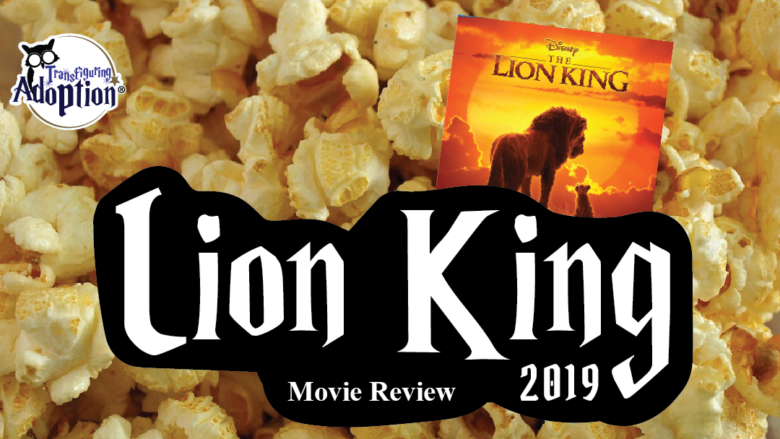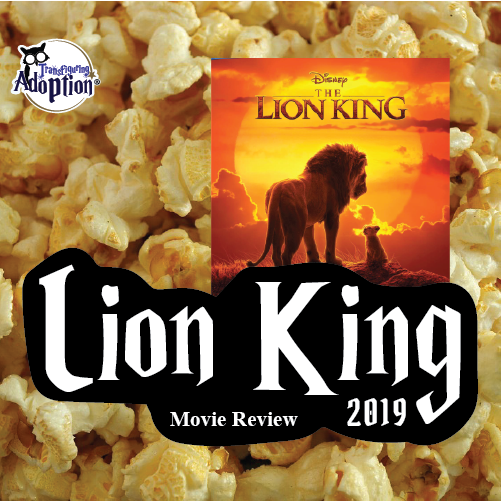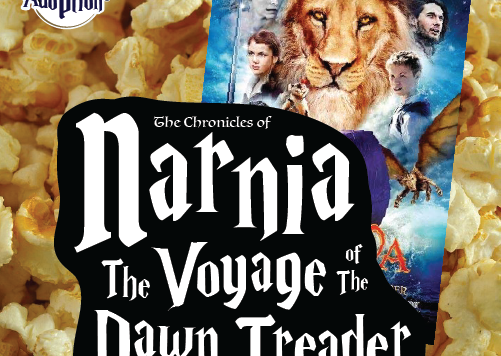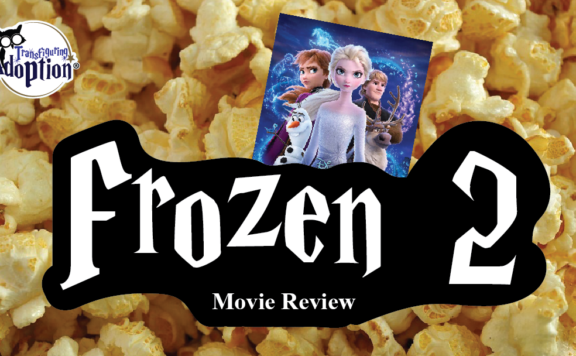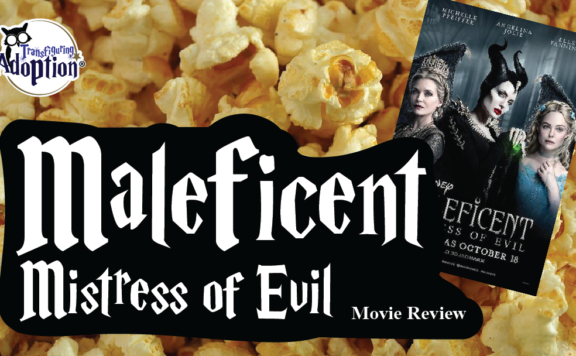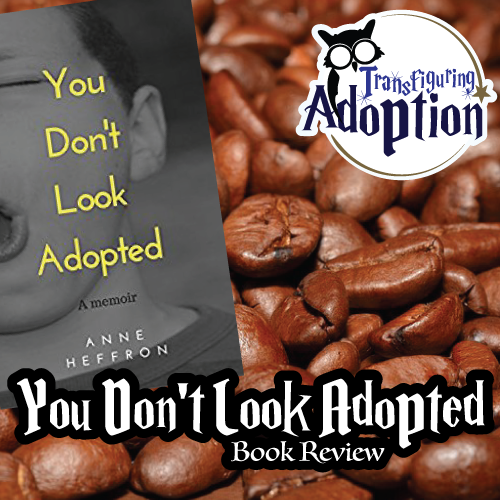Grade:
Transfiguring Adoption awarded this movie 4 Hoots out of 5 based on how useful it will be for a foster/adoptive family. [Learn more about our Hoot grading system here]
Movie Info:
From the Cover of The Lion King by Disney:
“Simba idolizes his father, King Mufasa, and takes to heart his own royal destiny on the plains of Africa. But not everyone in the kingdom celebrates the new cub’s arrival. Scar, Mufasa’s brother — and former heir to the throne — has plans of his own. The battle for Pride Rock is soon ravaged with betrayal, tragedy and drama, ultimately resulting in Simba’s exile. Now, with help from a curious pair of newfound friends, Simba must figure out how to grow up and take back what is rightfully his.”
The target audience appears to be children who are 7-adult. It also appears this movie would be best for most adoptive and foster families.
If you’re around my age (which is a secret) then you probably remember the 1994 “Lion King” film. Still to this day I can smell the popcorn and remember the sticky floors making loud noises as I walked to my seat during that first viewing. When I heard a remake was happening, I was actually appalled because NOTHING could ever replace my love for the original “Lion King” movie.
By now you’ve probably seen everyone complained about the CGI. I totally understand as I was not impressed either. However, if you’re watching the remake then it’s expected that 99% of people have seen the animated one and comparing the two is like comparing apples to oranges. My main concern was that the story line would be changed, and let me go ahead and provide some comfort, nothing changes.
Despite the storyline not changing, it’s still a great film that has wonderful ways to connect with your children. The film allows for conversations to be had about loss, grief, guilt, and fear which is something many of our children are familiar with.
** Spoilers Could Be Ahead **
How Is This Relevant To Adoption & Foster Care?
Simba is a newborn cub to King Mufasa and Sarabi. The film starts with the traditional Circle of Life that we have all come to know. Mufasa teaches Simba the ways of the animal kingdom and attempts to impart wisdom into him so that one day he can also be ruler of the kingdom. Mufasa’s brother, Scar, covets the title of being king and hatches a plan with his three hyena friends to kill Mufasa, blame it on Simba, and then kill Simba. Mufasa dies trying to save Simba from a stampede of wildebeests. Simba is heartbroken and becomes devastated when he sees his deceased father and when his uncle Scar blames him and suggests that he should run away. The hyena’s were unsuccessful in killing the young cub, who runs until he collapses into the desert. Simba is rescued by two other misfits, Timon and Pumba, who take him in and teach him the ways of living a ‘Hakuna Matata’ (no worries) lifestyle. This is a familiar event to many of our children because they are seperated from their parents, lost and confused on what happened, and often times end up in the care of total strangers. Simba does not speak much about his background, and instead grows up with Timon and Pumba in the tropical oasis they call home.
Nala demonstrates a new role in this Disney remake, which is refreshing. The 2019 version shows Scar attempting to make Sarabi his his wife. Nala has a desire to sneak out for help but Sarabi warns her that it is not safe and she does not heed her mother’s warning and goes looking for help. Many of our children have experienced wanting to obtain help for their families by talking to teachers or a close friend but were discouraged, fearing the consequences.
In her search for help, Nala spots Timon and Pumba who she tries to attack and eat. Simba rescues his friends, but then Nala recognizes him and is shocked that he is still alive, as they were informed he died. Simba thinks back to the events that happened when he lived at Pride Rock and feels immense guilt, believing that he is at fault for his father, Mufasa’s death. Sometimes our children are confronted with reminders of their past, whether that be an old neighbor, an old classmate, or a distant relative.
Simba refuses Nala’s request and runs into an open field where he is met by Rafiki who reminds him that his father’s spirit lives inside of him. Often times, our children have heard a lot of bad stories about their biological parents, whether from case managers, previous foster parents, or older siblings. This can cause children to believe that since their biological parents are bad, this means that they are bad. Although in this case Simba did not feel this way, it’s good to recognize that anything that is said about your child’s biological parents is done with the understanding that they are internalizing it and it will affect how they view themselves.
Discussion Points:
- Simba saw his father die which affected his belief about himself for a long time. This can open up a conversation about any guilt your children have about feeling responsible for some of their parents’ choices.
- Timon and Pumba were like a typical foster family, taking Simba in and teaching him a new way of living. This can help our children talk about their experiences in various foster homes and some of the new rules they had to learn.
- Simba provided mercy to Scar when begged, however Scar exploited Simba’s kindness. Many of our children have tried to forgive their family for hurting them and continued to be abused. Use this as an opportunity to talk about mercy and forgiveness.
- Simba returned to him homeland and Timon and Pumba came with him. Simba was able to successfully integrate both of his lives. Many of our children desire to have a relationship with their biological parents. Use this as an opportunity to allow your children to talk about whether they would like any relationship with their biological family in the future and what this would look like to them.
Cautionary Points:
- Violence: the story line is essentially the same in both movies in terms of murder, death, and fighting. However, due to CGI it is much more real looking. The hyenas and Scar appear to be more menacing in this version, which makes it all the more scary and heart-wrenching when bad things happen. Children who come from a background of exposure to physical abuse, domestic violence, or threats of injury may be more triggered from this live action version.
- Death: One of the most heartbreaking parts of this film is when Mufasa plunges to his death at the hands of his brother, someone he was supposed to be able to trust. Many of our kiddos feel betrayed when the people who are supposed to love and care for us sometimes do the worst things to us. Maybe they were lucky and did not see a family member kill someone they love, but they might have seen a family member hurt someone else that they care about or even themselves.
- Abandonment: When Simba escapes Scar’s attempt at murdering him in the gorge, he runs until he collapses in a desert and is rescued by Timon & Pumba, a meerkat and a warthog. Simba continues to reside with Timon and Pumba until he enters young adulthood, which for lions may not be as long as it is for humans. Many of our children can identify starting to live with someone new from when they entered foster care. Simba has to learn a way new of life by living with Timon and Pumba, and this can be a trigger for many of our kids because it may remind them of all of the new rules and values they had to learn throughout their time in foster care.
Discussion Guide:
- Why do you think Scar wanted to rule the Pride Lands so badly?
Caregiver Note: Jealousy is a normal emotion that many of our children have experienced. Whether it is jealousy over physical items that their friends have that they do not or even jealous that their friends have a permanent family when our kids are in foster care, it can cause many of our children to lash out in unexpected ways. - How do you think Simba should have dealt with the sadness he had when his dad died?
Caregiver Note: This question is a great way to assess what coping skills your kiddos already possess. If they aren’t able to provide a valid response, this is a really easy way to connect and figure out how they may potentially react in a similar situation when dealing with loss again. Although your child may not have ever experienced a loved one dying, being adopted or placed into foster care carries its own form of grief. Many children are at risk of developing unhealthy coping skills because no one else ever took the time to teach them healthy coping skills. This is the perfect opportunity to reinforce to kids that it’s okay to be sad and miss their loved ones. - The motto ‘Hakuna Matata’ means no worries, what would life look like for you if you didn’t have any worries?
Caregiver Note: Many of our kids experience some form of anxiety on a regular basis. It may be due to going to school, driving down a certain road, or hearing a certain song. There are many triggers that our kids have that we are unaware of until it triggers an anxiety attack. Comparing how your child’s life with no worries looks like to their current life can help give you some insight as to what worries them and how to create coping skills to manage their fears safely. - Why do you think Simba did not tell Timon and Pumba about his past?
Caregiver Note: A lot of our kids are very guarded about their past. Talking about it can become very triggering and many of them want to forget the abuse they have suffered. However, by not talking about the past it also prevents any positive memories from being shared. Learning about Simba’s past was a shock to Timon and Pumba, but they continued to be there for their friend and did not let that affect their relationship. This is a great opportunity to remind your child that no matter where they came from, you accept all of them- the good and the bad. - Why do you think Nala disobeyed her mother to leave the Pride Lands to find help?
Caregiver Note: A lot of times our children have a trusted adult they can tell things to, whether a teacher, a friend’s parent, or someone at church. They often don’t because they are afraid of what will happen to their family. They may have been told that it would be their fault if the family became separated. It took a lot of courage for Nala to leave her home and go into a world she never knew for help. Use this opportunity to help her child learn that sometimes making the right decision is hard and requires bravery, but is worth it in the end. - What do you think about Timon and Pumba staying with Simba in the Pride Lands?
Caregiver Note: Many of our children who have resided in foster care can see the parallel between foster parents and Timon and Pumba. In some situations, children are reunified with their biological parents and never have any connection with their foster parents post reunification. Seeing Timon and Pumba follow Simba to his homeland can open doors for a conversation on how children would like to stay connected with the people that have cared for them. If your child is adopted, use this as a conversation starter to assess what their interest is in maintaining a relationship with this biological family (if it is appropriate and safe). They may have no desire at this time but as they get older they may want to find them for various reasons. Having these conversations early will help your child feel comfortable in confiding their desires and feelings about their biological family to you. - How do you think the Pride Lands are different now that Simba is king instead of Scar?
Caregiver Note: This is a great way to help your kids use their imagination. Many of our children have a hard time imagining a better world because of the negative events that they have experienced. By having a new king (parent) that is kind and compassionate (Simba) instead of cruel and selfish (Scar), can make a big difference in how the society (home life) functions. Use this as an opportunity to learn what your children believes makes a difference between a good king and a bad king. - Activity: Turn yourself into a lion!
Items you will need for this craft include a paper plate, scissors, a popsickle stick, a hot glue gun, and various construction paper colors of orange, yellow, and brown. Cut a hole into the middle of the paper plate, large enough to have an opening the size of your child’s face. Cut strips of construction paper and glue to the outside of the plate, going outwards to create the mane. Hot glue the popsickle stick to the bottom as a handle. Enjoy the memories and practice your best lion faces and roars for the camera. - Activity: Make a Motto!
Timon and Pumba’s signature line is ‘Hakuna Matata’, which means no worries. Take this opportunity to engage with your child and create your own family motto. This motto should focus on what values your family holds. Dependability, compassion, honesty, and determination are all great starting points when trying to create a family motto. It can be silly or serious, as long as it fits with your family values. - What was your favorite part of the movie?
Caregiver Note: Although this question may seem to hold no value in engaging in a conversation, the parts of the movie that resonate with children the most are the parts where they can actively see themselves in the film. Maybe they identified with a certain character, or one of the characters reminded them of someone they loved. Exploring this can be fun and allows for everyone to talk about all the positive emotions the movie provided to them.
About the Author: Pattie Moore
Pattie lives in Tampa, FL, and she spends most of her time working with adoptive and foster families through case management, psychiatry services, and therapy services. Pattie received her bachelor’s in psychology from Saint Leo University and her master’s in Marriage and Family Therapy from Argosy University. Pattie has been certified as an adoption competent provider through Rutgers University. Pattie has also participated in the Infant Mental Health certification program through University of South Florida, and is currently working on her CPP (child parent psychotherapy) certification. Pattie is also a current Guardian Ad Litem for Hillsborough County that specializes in working with teen girls in human trafficking. When Pattie isn’t working, you can find her at Universal and Disney with her husband and friends.
**Transfiguring Adoption is a nonprofit organization seeking to nurture growth in foster and adoptive families by giving a HOOT about their families. Transfiguring Adoption does not intend for its reviewers nor its review to be professional, medical or legal advice. These reviews and discussion guides are intended to help parents to better be able to connect and understand their children who come from traumatic backgrounds.
